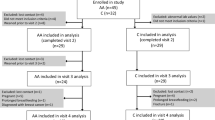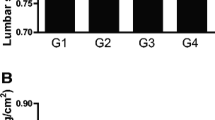Abstract
Background
Bone turnover is high during lactation. However, studies on bone status of Indian urban mothers are scarce. Hence, the objective was to conduct a cross-sectional study on the lactation-related changes in bone health status of Indian mothers postpartum using Dual X-ray Absorptiometry (DXA) at 3 time points: within a week of delivery, at 1- and 3-years postpartum. We also explored the association of dietary calcium intake, physical activity, serum vitamin D status, and dietary traditional food supplements (Dietary Food supplements) with bone health.
Methods
A cross-sectional study was conducted; 300 full-term, healthy primiparous women (28.6 ± 3.4 year) were randomly selected and categorized into 3 groups: 128 mothers within 7 days of delivery (Group A), 88 with 1-year-old children (B), and 84 with 3-year-old children (C). Anthropometry, lactation history, physical activity, diet, biochemical tests (vitamin D, parathyroid hormone), body composition, areal bone mineral density (a-BMD) at total body (TB), AP spine (APS), and dual neck femur (DF) were assessed by DXA (GE-Lunar DPX).
Results
Significantly higher APS-BMD (mean ± SD) was observed in Group C (1.107 ± 0.098 g/cm2) than that in A (1.045 ± 0.131 g/cm2) (p < 0.05). When adjusted for breastfeeding practices, mean (±standard error) APS-BMD was lowest in women in Group A (1.024 ± 0.013 g/cm2), but was higher at 1-year (1.079 ± 0.02 g/cm2) and at 3-years postpartum (1.111 ± 0.019 g/cm2), though differences were significant only between groups A and C (p < 0.05). Most mothers from all 3 groups consumed inadequate amount of nutrients except dietary fat and showed low physical activity. Multiple regression analysis indicated that dietary calcium, moderate physical activity, serum vitamin D, and consumption of dietary food supplements were not significant predictors of APS-BMD (p > 0.1).
Conclusion
Prevalence of nutrient and vitamin D deficiencies, low physical activity, and poor sunlight exposure were major concerns in Indian lactating mothers; improvement in bone mass at APS was observed at 3-years which was most likely due to physiologic changes.
Similar content being viewed by others
Abbreviations
- a-BMD:
-
Areal bone mineral density
- BMC:
-
Bone mineral content
- TB:
-
Total body
- APS:
-
Anterior–posterior spine
- DF:
-
Dual femur
- DXA:
-
Dual-energy X-ray absorptiometry
- LBM:
-
Lean body mass
- DFS:
-
Dietary food supplement
- NDS:
-
No dietary food supplement
- RDA:
-
Recommended dietary allowances
References
Ward KA, Adams JE, Mughal MZ. Bone status during adolescence, pregnancy and lactation. Curr Opin Obstet Gynecol. 2005;17(4):435–9.
Kovacs CS, Fuleihan G-H. Calcium and bone disorders during pregnancy and lactation. Endocrinol Metab Clin North Am. 2006;35(1):21–51.
López JM, González G, Reyes V, et al. Bone turnover and density in healthy women during breastfeeding and after weaning. Osteoporos Int. 1996;6(2):153–9.
Kalkwarf HJ, Specker BL, Bianchi DC, et al. The effect of calcium supplementation on bone density during lactation and after weaning. N Engl J Med. 1997;337(8):523–8.
Kawatra A, Sehgal S. Nutrient intake of lactating mothers from rural and urban areas. Indian J Soc Res. 1998;39(2):91–9.
Bhatia BD, Banerjee D, Agarwal DK, et al. Dietary intakes of urban and rural pregnant, lactating and non-pregnant, non-lactating vegetarian women of Varanasi. Indian J Med Res. 1981;74:680–7.
Kota S, Jammula S, Kota S, et al. Correlation of vitamin D, bone mineral density and parathyroid hormone levels in adults with low bone density. Indian J Orthop. 2013;47(4):402–7.
Harinarayan CV, Ramalakshmi T, Prasad UV, et al. High prevalence of low dietary calcium, high phytate consumption, and vitamin D deficiency in healthy south Indians. Am J Clin Nutr. 2007;85(4):1062–7.
Mogren IM. Breast feeding pattern may be associated with persistent low back pain and pelvic pain half a year postpartum. Open Epidemiol J. 2009;2:26–33.
Kajale N, Khadilkar A, Chiplonkar S, et al. Impact of traditional food supplements on nutritional status of lactating mothers and growth of their infants. Nutrition. 2014;30(11–12):1360–5.
Kaushik D, Mathew S. Nutritional composition of traditional supplementary foods consumed by lactating women. Indian J Nutr Diet. 1988;25:320–4.
Arora J, Ramawat KG. Biology and biotechnology of Gum yielding Indian Trees. Tree Biotechnology. 1 sted. New York: CRC Press Inc: Ramawat; 2014. p. 125.
Mandruzzato G. Intrauterine growth restriction (IUGR): guidelines for definition, recognition and management. Arch Perinat Med. 2008;14:7–8.
Arnold F, Parasuraman S, Arokiasamy P, et al. Nutrition in India. National Family Health Survey (NFHS-3), India, 2005-06. Mumbai: International Institute for Population Sciences; Calverton: ICF Macro 2009.
Mihrshahi S, Oddy WH, Peat JK, et al. Association between infant feeding patterns and diarrhoeal and respiratory illness: a cohort study in Chittagong, Bangladesh. Int Breastfeed J. 2008;3:28.
Chiplonkar SA, Agte VV, Tarwadi KV, et al. Micronutrient deficiencies as predisposing factors for hypertension in lacto-vegetarian Indian adults. J Am Coll Nutr. 2004;23(3):239–47.
Physical activity for everyone. http://www.cdc.gov/physicalactivity/everyone/guidelines/adults.html
Harinarayan CV, Ramalakshmi T, Prasad UV, et al. Vitamin D status in Andhra Pradesh: a population based study. Indian J Med Res. 2008;127(3):211–8.
C Diet: version 2. Xenios technology, 2012.
Chiplonkar SA, Agte VV. Extent of error in estimating nutrient intakes from food tables versus laboratory estimates of cooked foods. Asia Pac J Clin Nutr. 2007;16(2):227–39.
Gopalan C, Ramasastri BV, Balasubramanian SG. Revised and updated by Rao BSN, Deosthale YB, Pant KC, Nutritive value of Indian foods, Published by National Institute of Nutrition, Hyderabad, India, (1993), Reprinted: 2000.
USDA nutrient database for standard reference; release 23.
Johnson J, Dawson-Hughes B. Precision and stability of dual-energy X-ray absorptiometry measurements. Calcif Tissue Int. 1991;49(3):174–8.
Khadilkar AV, Chiplonkar SA, Pandit DS, et al. Metabolic risk factors and arterial stiffness in Indian children of parents with metabolic syndrome. J Am Coll Nutr. 2012;31(1):54–62.
Kumar N, Shekhar C, Kumar P, et al. Kuppuswamy’s socioeconomic status scale-updating for 2007. Indian J Pediatr. 2007;74(12):1131–2.
Indian Council of Medical research (ICMR). Nutrient requirements and recommended dietary allowances for Indians, a report of the expert group of the Indian Council of Medical Research. Hyderabad: National Institute of Nutrition; 2010.
WHO study group on assessment of fracture risk and its application to screening for post menauposalosteoporosis. WHO Technical Reports Series 843, 1994
Ghannam NN, Hammami MM, Bakheet SM, et al. Bone mineral density of the spine and femur in healthy Saudi females: relation to vitamin D status, pregnancy, and lactation. Calcif Tissue Int. 1999;65(1):23–8.
Kalkwarf HJ, Specker BL. Bone mineral loss during lactation and recovery after weaning. Obstet Gynecol. 1995;86(1):26–32.
Polatti F, Capuzzo E, Viazzo F, et al. Bone mineral changes during and after lactation. Obstet Gynecol. 1999;94(1):52–6.
Jain V, Gupta N, Kalaivani M, et al. Vitamin D deficiency in healthy breastfed term infants at 3 months & their mothers in India: seasonal variation & determinants. Indian J Med Res. 2011;133:267–73.
Agarwal N, Faridi MM, Aggarwal A, et al. Vitamin D Status of term exclusively breastfed infants and their mothers from India. Acta Paediatr. 2010;99(11):1671–4.
Farrant HJ, Krishnaveni GV, Hill JC, et al. Vitamin D insufficiency is common in Indian mothers but is not associated with gestational diabetes or variation in newborn size. Eur J Clin Nutr. 2009;63(5):646–52.
Sachan A, Gupta R, Das V, et al. High prevalence of vitamin D deficiency among pregnant women and their newborns in northern India. Am J Clin Nutr. 2005;81(5):1060–4.
Møller U, Ramlau-Hansen C, Rejnmark L, et al. Postpartum vitamin D insufficiency and secondary hyperparathyroidism in healthy Danish women. Eur J Clin Nutr. 2006;60(10):1214–21.
Maddah M, Nikooyeh B. Weight retention from early pregnancy to three years postpartum: a study in Iranian women. Midwifery. 2009;25(6):731–7.
Yoon JS, Hee J, Park JA. A study on calcium and iron status of lactating women. Korean J Nutr. 2005;38(6):475–86.
Evenson KR, Aytur SA, Borodulin K. Physical activity beliefs, barriers, and enablers among postpartum women. J Womens Health (Larchmt). 2009;18(12):1925–34.
Kulkarni B, Shatrugna V, Nagalla B, et al. Regional body composition changes during lactation in Indian women from the low-income group and their relationship to the growth of their infants. J Am Coll Nutr. 2011;30(1):57–62.
Bandyopadhyay M. Impact of ritual pollution on lactation and breastfeeding practices in rural West Bengal, India. Int Breastfeed J. 2009;4:2. doi:10.1186/1746-4358-4-2.
Acknowledgments
Authors gratefully acknowledge the financial support provided by Mr. Pancharatnam, Panchasheel Filters, Pune. We thank to Director, HCJMRI, Dr. Uma Divate for giving permission for carrying out this study. Also, we would like to express gratitude to all the mothers for their participation and cooperation during the study.
Author information
Authors and Affiliations
Corresponding author
Ethics declarations
Conflict of interest
All authors have no conflict of interest.
Ethical approval
Research protocol was approved by the institutional ethics committee and all participants gave written informed consent.
Additional information
Neha Kajale is a Research Scholar at Hirabai Cowasji Jehangir Medical Research Institute, Jehangir Hospital, Pune.
Appendix
Appendix
See Table 3.
Rights and permissions
About this article
Cite this article
Kajale, N., Khadilkar, A., Chiplonkar, S. et al. A Cross-Sectional Study of Postpartum Changes in Bone Status in Indian Mothers. J Obstet Gynecol India 66, 218–225 (2016). https://doi.org/10.1007/s13224-015-0746-1
Received:
Accepted:
Published:
Issue Date:
DOI: https://doi.org/10.1007/s13224-015-0746-1




